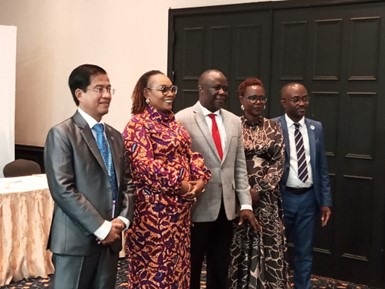To enhance the nutritional level of food consumed by schoolchildren under the Ghana School Feeding Programme (GSFP), a highly nutritious but affordable pelagic fish product has been included in the programme
The GSFP currently has about 3.8 million children from 9,700 primary and junior high schools across the country, and the addition of pelagic fish will ensure proper nutrition for beneficiaries.
The GSFP has come under intense criticism in recent times for the poor quality of food provided to children at the basic level, with heightened calls for the feeding fee to be increased from 0.9 pesewas to a minimum GH₵2 per child.
Government has however expressed inability to pay the proposed fee due to the current economic downturn.
Recognising the critical role that nutrition plays in children’s mental development, physical growth and overall well-being, the Food and Agriculture Organisation (FAO) of the United Nations – in collaboration with the Fisheries Commission (FC), Ministry of Fisheries and Aquaculture (MoFA), and Council for Scientific and Industrial Research Food Research Institute (CSIR-FRI) – developed this pelagic fish product to enhance the quality of meals for students to receive nutritious and well-balanced meals each day.
This fish product – termed small fish – is made from herring, anchovies and other vitamin-rich fish by-products that were hitherto discarded.
The small fish product comes in powdered form, and when incorporated into the dietary guideline for children will provide them with adequate energy and essential nutrients, and promote healthy eating habits.
Executive Director of Fisheries Commission, Fred Antwi Boadu, emphasised that over the years, the Commission has shown commitment to ensuring safe fish for consumption through the introduction of improved technologies and licencing regulations.
“We understand that fish is an essential nutritional element in children’s brain-health and cognitive development. Therefore, supporting the scientific study to introduce improved fish in school meals was a welcome initiative to us. Small fish hold incredible potential to meet the nutritional needs of children, and I am glad we have finally found a way to include it in our children’s diet.
“This partnership with the FAO, like several others in the past, is aimed at ensuring Ghanaians get safe and improved fish products – high in nutrition for consumption and attaining body requirement needs for growth,” he said.
Minister of Fisheries and Aquaculture Development, Mavis Hawa Koomson, reiterated that the decision to add small fish to the GSFP is laudable because it contains the necessary nutrients for development of the body.
“Fish is very rich in Omega-three acids which are good for brain function. The good news here also is that small fish is the most abundant in our waters as a country, and therefore ensures the programme’s sustainability. We will ensure the use of good fish processing technologies to safeguard fish preservation and storage.
“The inclusion of small fish in the GSFP is a major step toward attaining a healthier population in future. The nutrition of Ghanaians, especially children, is a shared responsibility; and instituting the GSFP is one of the ways to achieve that,” she said.
She assured that the ministry will create effective linkages between fish producers and caterers of the GSFP to ensure availability of the small fish product for use to put a stop to the challenge of children eating food without any protein or fish and meat products due to inadequate funds.
These remarks were made at the national workshop to disseminate a policy brief on the inclusion of small fish into the GSFP and nutrition education materials.










